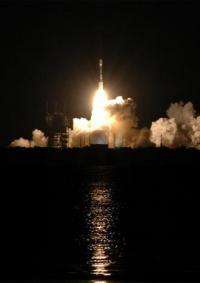STEREO Launches Hi-Def Solar Imagers

NASA's twin Solar Terrestrial Relations Observatories mission, known as STEREO, successfully launched Wednesday at 8:52 p.m. EDT from Cape Canaveral Air Force Station, Fla.
STEREO's nearly identical twin, golf cart-sized spacecraft will make observations to help researchers construct the first-ever three-dimensional views of the sun. The images will show the star's stormy environment and its effects on the inner solar system, vital data for understanding how the sun creates space weather.
"The stunning solar views the two observatories will send back to Earth will help scientists get a better understanding of the sun and its activity than we've ever been able to obtain from the ground or any of our other missions," said Nick Chrissotimos, STEREO project manager at NASA's Goddard Space Flight Center, Greenbelt, Md.
The two observatories were launched on a Delta II rocket in a stacked configuration and separated from the launch vehicle approximately 25 minutes after lift-off. After receiving the first signal from the spacecraft approximately 63 minutes after launch, mission control personnel at the Johns Hopkins University Applied Physics Laboratory (APL), Laurel, Md., confirmed each observatory's solar arrays successfully deployed and were providing power. NASA's Deep Space Network antennas in Canberra, Australia received the initial radio signals.
During the next two weeks, mission managers at APL will ensure all systems are properly working. For the next three months, the observatories will fly from a point close to Earth to one that extends just beyond the moon's orbit.
After about two months, STEREO's orbits will be synchronized to encounter the moon. The "A" observatory will use the moon's gravity to redirect it to an orbit "ahead" of Earth. The "B" observatory will encounter the moon again for a second swing-by about one month later to redirect its position "behind" Earth. STEREO is the first NASA mission to use separate lunar swing-bys to place two observatories into vastly different orbits around the sun.
Just as the slight offset between human eyes provides depth perception, this placement will allow the STEREO observatories to obtain 3-D images of the sun. The arrangement also allows the two spacecraft to take local particle and magnetic field measurements of the solar wind as it flows by.
During the observatories' two-year mission, they will explore the origin, evolution and interplanetary consequences of coronal mass ejections, some of the most violent explosions in our solar system. These billion-ton eruptions can produce spectacular aurora, disrupt satellites, radio communications and Earth's power systems. Energetic particles associated with these solar eruptions permeate the entire solar system and can be hazardous to spacecraft and astronauts.
Better prediction of solar eruptions provides more warning time for satellite and power grid operators to put their assets into a safe mode to weather the storm. A better understanding of the nature of these events will help engineers build better and more resilient systems.
"We're becoming more and more reliant on space technologies in our everyday lives and are hatching ambitious plans to explore our outer space surroundings," said Michael Kaiser, STEREO Project Scientist at Goddard. "But nature has a mind of its own and STEREO is going to help us figure out how to avoid those surprises the sun tends to throw at us and our best-laid plans."
Source: NASA





















